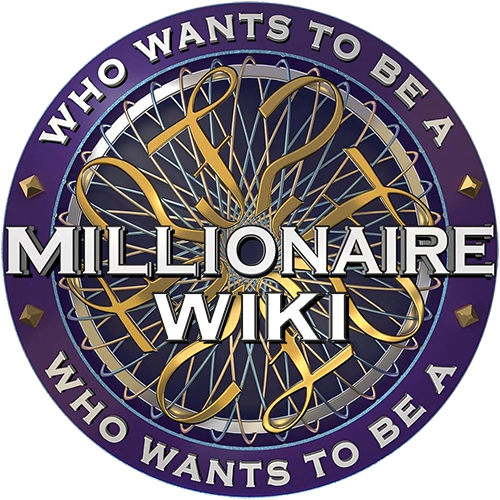Who Wants to Be a Millionaire (also known as Millionaire) is an American television game show based upon the British program of the same title, which offers a maximum prize of $1,000,000 for correctly answering a series of consecutive multiple choice questions. The program follows the same general premise as its original UK counterpart, and is one of many international variants in the Who Wants to Be a Millionaire? franchise.
Originally, as in the UK edition, contestants were required to correctly answer fifteen questions of increasing difficulty; however, in 2010, the format was modified so that the contestants were faced with ten questions of random difficulty and prize value followed by and a second level of four questions of increasing difficulty referred to as "Classic" Millionaire. Nevertheless, in 2015, the program returned to a more classic version of gameplay, in which contestants will be required to correctly answer fourteen questions of increasing difficulty and fixed value in order to win the million dollar prize.
The original U.S. version aired on ABC from August 16, 1999 to June 27, 2002, and was hosted by Regis Philbin. The current syndicated version of the show began airing on September 16, 2002, and was launched by Meredith Vieira, who remained host for eleven seasons, with her final first-run episode airing on May 31, 2013. In the seasons that followed, Vieira was succeeded by Cedric the Entertainer in the 2013–14 season, Terry Crews in the following season (2014–15), and Chris Harrison in the 2015-2016 season.
As the first U.S. network game show to offer a million-dollar top prize, the show made television history by becoming one of the highest-rated game shows in the history of American television. The U.S. Millionaire has gone on to win seven Daytime Emmy Awards, and TV Guide and Game Show Network (GSN) have ranked it #7 and #5 on their respective lists of the 50 Greatest Game Shows of All Time. In 2013, TV Guide ranked it #6 in its list of the 60 greatest game shows ever.
History
Primetime version

Regis Philbin hosted the original primetime version.
Who Wants To Be A Millionaire debuted in the United States on August 16, 1999 on the ABC television network, and was hosted by television personality Regis Philbin.
The network version, whose episodes were originally shown just a day after their taping in New York, became explosively popular in 2000, and at its peak was airing in prime time four nights a week on ABC. The show was popular enough to find rival networks creating or reincarnating game shows of their own, and created a brief renaissance of sorts for United States based game shows (e.g. Greed, Twenty One, etc.) as well as a flurry of American versions of UK and Australian originals, such as Winning Lines, The Weakest Link, and It's Your Chance of a Lifetime.
ABC used Who Wants To Be A Millionaire in so many prime time slots that when the show's popularity faded by the fall of 2001, it was left with a dearth of original programs on June 27, 2002. ABC's overall Nielsen Ratings suffered as a result of the show's decline in popularity. Michael Eisner, then CEO of The Walt Disney Company (ABC's parent), a former page at Jeopardy! and The Price Is Right, thought that the show would be successful like many other daytime television shows. However, he had realized too late that a hot show like Millionaire would tire more quickly in prime time than in daytime.[2]
However, to celebrate Millionaire's 10th anniversary, the show returned to ABC prime time in August 2009 with host Regis Philbin for a two week event.
Syndicated Version

Meredith Vieira hosted the first 11 syndicated seasons.
In 2002, Disney's Disney-ABC Domestic Television started selling a new version of the show for daily syndication, with a new host, Meredith Vieira (who previously appeared on the nighttime show and won $250,000 during a celebrity week where all the money would go to charities related to victims of 9/11). It was initially proposed and developed under the assumption that the prime time show would still be airing on ABC, but the prime time show was canceled a few months before the syndicated show premiered.
The syndicated version premiered in September 2002, and began airing its fourteenth season on September 14, 2015, and has earned Vieira two Emmies for best game show host.[3] The format is licensed by Sony Pictures Television as part of the acquisition of 2waytraffic in 2008, though the U.S. version is still distributed by Disney.
The syndicated version does not include the Fastest Finger competition; contestants are brought out individually during each half-hour show after passing contestant auditions, consisting of a written test and an interview.
Qualifications
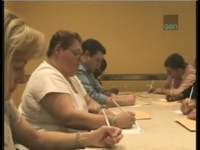
Potential contestants taking the general-knowledge test.
Unlike the original network version, where aspiring contestants made a phone call, answered a few questions correctly on the phone, and were randomly selected, leading to a Fastest Finger competition to determine the player in the hot seat, the current version uses a more traditional game-show procedure, similar to what is used for most games. This toughens the contestant pool.
Contestants, depending on touring tryouts or tryouts held at ABC's New York studio center, are required to pass a quiz between 30 and 40 questions which is electronically scored.
Contestants who pass the general-knowledge test are then interviewed by production staff. People who impress the production staff the most are later sent a postcard in the mail stating that he/she is in a pool of to-be contestants, which by the producers' discretion are sent to New York for their tapings.[4]
Fill-In Hosts
Since 2007, guest-hosts have appeared in the second half of each season due to Meredith's busy schedule.
- Al Roker (March 5–9, 2007)
- Tom Bergeron (May 14–18, 2007)
- Tim Vincent (June 25–29, 2007)
- Dave Price (March 3–7, 2008)
- Billy Bush (April 21–25, 2008; was also an expert in Season 7)
- Leeza Gibbons (June 23–27, 2008)
- Cat Deeley (February 16–20, 2009)
- Samantha Harris (May 11–15, 2009)
- Shaun Robinson (June 8–12, 2009)
- Regis Philbin (November 30-December 4, 2009; original primetime-version host)
Gameplay
At its core, the game is a quiz competition in which the goal is to correctly answer a series of consecutive multiple-choice questions. However, the format of the show has been overhauled multiple times along its lifetime.
Fastest Finger
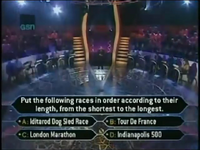
A Fastest Finger question in progress.
On all of the ABC versions (including the Super Millionaire spin-off and the 10th Anniversary Celebration), ten contestants competed in a one question playoff, known as the Fastest Finger question, for the right to play the main game. During this round, the host would read one question and four items that had to be arranged in a specific order. Each contestant would try to input the correct order, using keys on the podiums in front of them, with a time limit of 20 seconds. The person who did so correctly in the fastest time would join the host in the Hot Seat and begin the main game.
If two or more contestants tied on time, they would play an additional Fastest Finger question to break the tie. If none of the contestants answer the question correctly, they would all play as many Fastest Fingers questions as needed until at least one contestant gets it right. If the main game ended and there was still time available for another game, the remaining contestants played another Fastest Finger round for a chance to play the main game.
If any of the contestants are visually-impaired, the host would read the question and 4 choices all at once (which are included in an envelope), then repeat the choices after the music began.
The Fastest Finger question was eliminated from the gameplay when the syndicated version premiered in 2002, each contestant being brought out individually instead.
Main game
Original format
On the primetime version of the show and during the first eight seasons on syndication, a contestant was asked a series of up to 15 consecutive multiple-choice answers of increasing difficulty. Each question had a fixed cash value, and if they were to be answered correctly, the contestant's total earnings would be raised to that value (for example, giving a correct answer to the $500 question would increase their earnings to $500, not by $500). This would continue until either the contestant answered all 15 questions correctly, miss a question or decide to walk away with all of the money they had received thus far. Any of these conditions being met marked the end of a contestant's game.
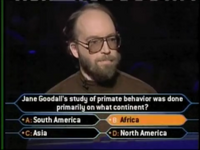
A contestant has declared his final answer, marked in orange.
Up until the sixth syndicated season, there was no time limit, meaning that a contestant could take as much time to answer a question as they needed. Most contestants who could not answer a question immediately often thought out loud, and tried to work out the answers by either elimination or other means. However, in order for an answer to be considered valid and binding, the contestant must confirm it is what they intend to play by either stating Final answer, Final, or anything similar. The iconic phrase "Is that your final answer?" exists because of this rule, and is said by the host to a contestant when they seem to be committing to an answer but do not do so correctly. However, during the first five questions, segments of contestants stating that their answers are final are often cut out or even do not happen in order to speed up gameplay.
Questions 5 and 10 were known as milestone questions, because if they were to be answered correctly, they would increase the contestant's minimum payout to the cash value they had attached. If at any moment a contestant gave a wrong answer, their total winnings would be reduced to the cash value attached to the last milestone question correctly answered. For example, on the primetime version, answering questions 7 or 11 incorrectly would reduce a contestant's winnings from $4,000 to $1,000 and from $125,000 to $32,000 (or $100,000 to $25,000 on Seasons 3-8 of the syndicated version). A direct consequence of this was that questions 6 and 11 ($2,000 and $64,000; $50,000 from Seasons 3-8 of the syndicated version) were freebies, because they could be answered without fear of losing any accumulated money.
Because there is no initial milestone question, a contestant could leave empty handed if they provide a wrong answer to any of the first five questions. The first person to do so, Robby Roseman, and its infamous answer to the $100 question "Hannibal crossed the Alps using what animals?" were responsible for the creation of the term llama among the show's fans to refer to any contestant who misses any of the first five questions and leaves the show empty-handed.
Clock format
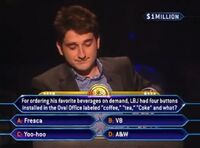
Ken Basin's Million Dollar Question.
At the start of the seventh syndicated season, time limits were introduced to each question. The host would read a question, and as the four answers appear simultaneously, the clock would start ticking down, even while the host is reading the four possible choices. The contestant is not required to wait for the host to read all the answers, they can commit to an answer as soon as it appears (Alan Carver being the most notable example).
Contestants had up to 15 seconds to answer questions one through five, up to 30 seconds for questions six through ten, and up to 45 seconds for questions eleven through fifteen. However, any unused time from the first fourteen questions was added to the clock during the last question, giving contestants much more time to think through the million dollar question. If a contestant runs out of time before committing to an answer, they are forced to walk away with the winnings they had until that point, unless certain conditions are met.
During this format, contestants had access to a revamped money tree, that presented them the categories for all of the questions they had yet to answer. Also introduced during this era were Celebrity questions. Most often found in mid-tier questions, these were provided by notable individuals whose identities were not revealed until the contestant reached their special questions. Barring a few other exceptions, the clock format was identical to the original format in every other way.
Shuffle format
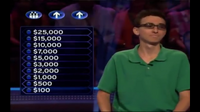
These 10 money values were assigned at random to the 10 questions of the Super Mix round before gameplay began.
At the start of the ninth syndicated season, the show was given a complete overhaul. Alongside with the removal of the clock, gameplay was divided into two rounds, Super Mix and Classic Millionaire. During the Super Mix round, a contestant would face 10 questions with a certain money value attached to them. These 10 questions, originally sorted by difficulty, and the 10 money values (ranging from $100 to $25,000) were shuffled before gameplay started (hence the Super Mix name). Contestants were aware of the order in which the questions were shuffled (as they could look at the categories before and after the shuffle), but were not told the money values behind a question.
Correctly answering a question added the money value of the question to a contestant's bank; answering it incorrectly dropped the contestant's winnings to a consolation prize of $1,000 and meant their elimination from the game. A contestant who decided to walk away during this round would only take half of whatever they had banked up until that moment.
Aditionally, a contestant could also decide to jump a question, provided that they had not used all of their allocated jumps (two for Seasons 9 through 12, one for Season 13). When a contestant jumped a question, the correct answer was revealed, alongside with the money value behind the question. This money value was forfeited, but the contestant was allowed to keep playing. During this round, a contestant could bank up to $68,600 by answering all of the 10 questions correctly and not jumping any of them.
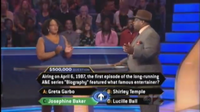
A contestant has just jumped the $500,000 question. She was shown the correct answer and was allowed to see the next question.
After getting through the 10 questions in the Super Mix round (either by correctly answering the tenth Super Mix question or by jumping it), the contestant entered the Classic Millionaire round, in which they would face 4 non-categorized questions worth $100,000, $250,000, $500,000 and $1,000,000 in that order. Unlike the previous round, the questions were of increasing difficulty, and answering a question correctly would only increase their bank contents up to the money value of the question. Furthermore, a contestant could walk away with the full contents of their bank during this round before commiting to an answer (even before answering the $100,000 question), but answering incorrectly any of the final four questions eliminated them from the game and reduced their bank contents back down to a safety net of $25,000. A contestant could also jump a question during this round, provided they had not used all of their allocated jumps and that they were not trying to jump the last question. Jumping a question this round also forfeited the money value behind a question, but meant that the contestant could attempt to answer a higher-valued question.
During this era, Double Your Money Weeks were introduced. Contestants who played during these weeks had a randomly chosen question from the Super Mix round have its money value doubled (the Double Money question). They were made aware of the position of this question before gameplay started, but were not told the value it contained until they had correctly answered the question. If a contestant decided to jump the Double Money question, this doubled value would be revealed to the contestant and be forfeited, and the contestant would be given no additional Double Money questions. During a Double Your Money week, a contestant could bank up to $93,600 during the Super Mix round by answering all 10 questions correctly and having had their $25,000 question doubled in value.
Current format
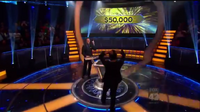
A contestant has just correctly answered the tenth question and acquired the second safety net. He could no longer walk away with anything less than $50,000.
At the start of the fourteenth syndicated season, the show saw another major overhaul, bringing it back closer to its roots. Gameplay is now similar to the format used in primetime and early syndication: a contestant faces a number of questions of increasing difficulty and money value; if they answer a question correctly, their bank would increase to the money value attached to the question, but if they answer it incorrectly, the contents of their bank would drop down to the value attached to the last safety net they had passed and mean their elimination from the game; in addition, a contestant could walk away with the full contents of their bank at any point during the game before committing to an answer.
Unlike the original format, a contestant only needs to correctly answer 14 questions (instead of 15) to win the top prize; and a contestant who is supposed to leave with nothing because they had answered a question incorrectly before acquiring the first safety net will be given a $1,000 consolation prize, although the host does not usually indicate this fact to the contestants while explaining the rules (in the original format, a contestant would leave empty-handed if they answer any question incorrectly before passing the first milestone and they would not be awarded any consolation money).
Lifelines
Before gameplay begins, contestants are given a selection of lifelines, designed to help a contestant who gets stuck at a particular question. Barring the Double Dip lifeline, contestants are free to use as many lifelines as they want in a particular question and are free to walk away from a question even after using them. However, contestants are only able to use each lifeline once, with the notable exception of the Jump the Question lifeline during the 2009/10-2013/14 seasons, as contestants were able to use this lifeline twice.
In the original primetime version and during the first six seasons on syndication, contestants were given three lifelines:
- 50:50: the computer would remove two wrong answers among the four possible choices, meaning that the contestant was left with the correct answer and one remaining wrong answer. Originally, the two wrong answers that were removed were predetermined by the production staff. This however changed later, and the two wrong answers were selected at random.
- Phone-A-Friend: the contestant could call one of five (three from the seventh syndicated season onwards) predetermined friends anywhere on the United States and would read them the question and the possible choices. The friend was given 30 seconds to try and answer the question, after which the call would be cut-off. However, the contestant was not forced to commit to the answer that their friend gave.
- Ask the Audience: the studio audience members were given 20 seconds to indicate the answer they thought was correct using an electronic keypad. The results were then tallied and shown to the contestant.
At the start of the third syndicated season, an additional lifeline was given to the contestants, provided that they had correctly answered the second milestone question:
- Switch the Question: the computer would switch the current question for another one worth the same money value. The contestant would be shown the correct answer of the old question before being shown the replacement one. Any lifelines used in the old question were not reinstated, and a contestant could not switch back to the original question.
At the start of the seventh syndicated season (the first Clock Format season), the Switch the Question and 50:50 lifelines were eliminated. In their place, the contestant was given two new lifelines:
- Double Dip: originally available in the Super Millionaire spin-off, a contestant was given two shots at answering a question, i.e., if their first locked in answer turned to be incorrect, they were given another chance at answering the question. The Double Dip lifeline was not restored if a contestant's first locked in answer turned to be correct. Unique to any lifeline in the series, after deciding to use the lifeline, the contestant was not able to use any other lifelines or walk away, so they were forced to either use all of their attempts or let the clock run down to zero. Should the latter happen, the contestant will be considered to have given an incorrect answer and they would be eliminated from their game, dropping their winnings to the last safe haven they had achieved.
- Ask the Expert: similar to the Three Wise Men lifeline in the Super Millionaire spin-off, a contestant was able to talk with an expert (usually a former Millionaire contestant or a celebrity) through a Skype video-call in order to determine the correct answer. If the Skype video-call failed, the contestant and the expert would communicate through a regular phone call. Unlike the Three Wise Men lifeline, a contestant was allowed to talk to the expert for as long as they wished. Similar to the Switch the Question lifeline, this lifeline originally was not available at the start of the game, and was only given to a contestant after they had correctly answered the first milestone question.
During the Clock Format era, the question clock would stop whenever the contestant stated that they would use a lifeline (and the contestant could actually use it), and would only resume once the results of the lifeline were let known to the contestant. However, if a contestant used their Double Dip lifeline and missed their first attempt, the clock would restart after the attempt was revealed to be incorrect.
On the episode broadcast on January 11, 2010, midway through the eighth season, the production staff announced that the Phone-A-Friend lifeline would be no longer offered to contestants, due to the rising number of phone-a-friends using Internet web searches or other media in order to unfairly aid a player, which according to the show, was against the original intent of the lifeline. In return, the Ask the Expert lifeline was given to a contestant before gameplay started, and would no longer need to earn it.
At the start of the syndicated Season 9 (the first Shuffle Format season), the Double Dip and Ask the Expert lifelines were eliminated. In their place, the contestant was given two Jump the Question lifelines:
- Jump the Question: the contestant would be able to skip the current question and see the following one, continuing gameplay as normal but forfeiting the money value attached to the old question, i.e., if used during the Super Mix round, the money value attached to the question would not be added to a contestant's bank, and if used during the Classic Millionaire round, the contestant's bank contents would remain the same (e.g. a contestant who had banked $68,600 and jumped the $100,000 question would still have $68,600 in their bank). If a contestant jumped the last Super Mix question, the $25,000 Classic Millionaire safety net would be activated as normal.
Beginning with the thirteenth season, one Jump the Question lifeline was eliminated. In its place, the contestant was given a new lifeline:
- Plus One: the contestant would be able to discuss the question with a designated companion (their '+1'), who sat in the studio audience. There was no time limit, and the +1 would stay with the contestant until they had locked in an answer.
During certain Special Weeks (most notably Halloween Weeks), contestants were given one of the following additional lifelines:
- Crystal Ball: only available during the Super Mix round, the contestant was shown the money value attached to the current question.
- Cut the Question: works similarly to Switch the Question (it replaces the current question with a new one). It also maintains the money value of the original question.
Starting in Season 14, the final Jump the Question lifeline was eliminated. In its place, the contestant was given the 50:50 lifeline, which has the same effects as the one available in the primetime and early syndication seasons (it removes two incorrect answers from the current question). Additionally, on weeks that feature the Cut the Question lifeline, it is stated that if a contestant were to use that lifeline, the replacement question would be easier in difficulty than the original question, but that they could only use this lifeline up to the tenth question (the second safety net question).
During the Off to College Week in Season 14, contestants were given an additional lifeline:
- Extra Help: could only be used after using the Plus One lifeline (but not necessarily during the same question); the contestant would be able to discuss the current question with another companion, similar to Plus One. On weeks featuring this lifeline, when a contestant decides to use the Plus One lifeline, they get to choose which companion gets to come down and help them first.
Money Tree
Primetime 1999-2002; Daytime 2002-2004
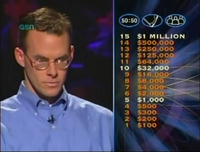
First money tree.
| Question No. |
Correct Answer Value |
Walk Away Value |
Miss Answer Value |
Amount Lost for a Wrong Answer |
|---|---|---|---|---|
| 1 | $100 | $0 | $0 | $0 |
| 2 | $200 | $100 | $0 | $100 |
| 3 | $300 | $200 | $0 | $200 |
| 4 | $500 | $300 | $0 | $300 |
| 5 | $1,000 | $500 | $0 | $500 |
| 6 | $2,000 | $1,000 | $1,000 | $0 |
| 7 | $4,000 | $2,000 | $1,000 | $1,000 |
| 8 | $8,000 | $4,000 | $1,000 | $3,000 |
| 9 | $16,000 | $8,000 | $1,000 | $7,000 |
| 10 | $32,000 | $16,000 | $1,000 | $15,000 |
| 11 | $64,000 | $32,000 | $32,000 | $0 |
| 12 | $125,000 | $64,000 | $32,000 | $32,000 |
| 13 | $250,000 | $125,000 | $32,000 | $93,000 |
| 14 | $500,000 | $250,000 | $32,000 | $218,000 |
| 15 | $1,000,000 | $500,000 | $32,000 | $468,000 |
Primetime 2009; Daytime 2004-2009
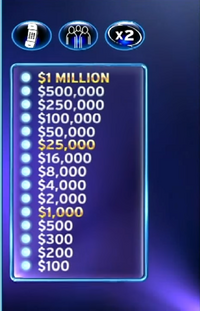
Second money tree.
| Question No. |
Correct Answer Value |
Walk Away Value |
Miss Answer Value |
Amount Lost for a Wrong Answer |
|---|---|---|---|---|
| 1 | $100 | $0 | $0 | $0 |
| 2 | $200 | $100 | $0 | $100 |
| 3 | $300 | $200 | $0 | $200 |
| 4 | $500 | $300 | $0 | $300 |
| 5 | $1,000 | $500 | $0 | $500 |
| 6 | $2,000 | $1,000 | $1,000 | $0 |
| 7 | $4,000 | $2,000 | $1,000 | $1,000 |
| 8 | $8,000 | $4,000 | $1,000 | $3,000 |
| 9 | $16,000 | $8,000 | $1,000 | $7,000 |
| 10 | $25,000 | $16,000 | $1,000 | $15,000 |
| 11 | $50,000 | $25,000 | $25,000 | $0 |
| 12 | $100,000 | $50,000 | $25,000 | $25,000 |
| 13 | $250,000 | $100,000 | $25,000 | $75,000 |
| 14 | $500,000 | $250,000 | $25,000 | $225,000 |
| 15 | $1,000,000 | $500,000 | $25,000 | $475,000 |
Daytime 2009-2010
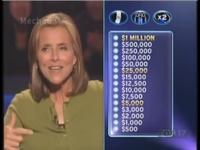
Third money tree.
| Question No. |
Correct Answer Value |
Walk Away Value |
Miss Answer Value |
Amount Lost for a Wrong Answer |
|---|---|---|---|---|
| 1 | $500 | $0 | $0 | $0 |
| 2 | $1,000 | $500 | $0 | $500 |
| 3 | $2,000 | $1,000 | $0 | $1,000 |
| 4 | $3,000 | $2,000 | $0 | $2,000 |
| 5 | $5,000 | $3,000 | $0 | $3,000 |
| 6 | $7,500 | $5,000 | $5,000 | $0 |
| 7 | $10,000 | $7,500 | $5,000 | $2,500 |
| 8 | $12,500 | $10,000 | $5,000 | $5,000 |
| 9 | $15,000 | $12,500 | $5,000 | $7,500 |
| 10 | $25,000 | $15,000 | $5,000 | $10,000 |
| 11 | $50,000 | $25,000 | $25,000 | $0 |
| 12 | $100,000 | $50,000 | $25,000 | $25,000 |
| 13 | $250,000 | $100,000 | $25,000 | $75,000 |
| 14 | $500,000 | $250,000 | $25,000 | $225,000 |
| 15 | $1,000,000 | $500,000 | $25,000 | $475,000 |
Daytime 2015-
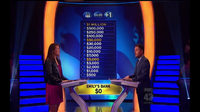
Current money tree.
| Question No. |
Correct Answer Value |
Walk Away Value |
Miss Answer Value |
Amount Lost for a Wrong Answer |
|---|---|---|---|---|
| 1 | $500 | $0 | $0 | $0 |
| 2 | $1,000 | $500 | $0 | $500 |
| 3 | $2,000 | $1,000 | $0 | $1,000 |
| 4 | $3,000 | $2,000 | $0 | $2,000 |
| 5 | $5,000 | $3,000 | $0 | $3,000 |
| 6 | $7,000 | $5,000 | $5,000 | $0 |
| 7 | $10,000 | $7,000 | $5,000 | $2,000 |
| 8 | $20,000 | $10,000 | $5,000 | $5,000 |
| 9 | $30,000 | $20,000 | $5,000 | $15,000 |
| 10 | $50,000 | $30,000 | $5,000 | $25,000 |
| 11 | $100,000 | $50,000 | $50,000 | $0 |
| 12 | $250,000 | $100,000 | $50,000 | $50,000 |
| 13 | $500,000 | $250,000 | $50,000 | $200,000 |
| 14 | $1,000,000 | $500,000 | $50,000 | $450,000 |
Super Millionaire
Main Article: Who Wants to Be a Super Millionaire
In 2004, Regis Philbin returned to ABC for 12 episodes of a spin-off Millionaire called Who Wants to Be a Super Millionaire, or better known as Super Millionaire, that offered a $10 Million top prize. The show premiered in February 2004 and showed 5 episodes. The show returned later in May 2004 for 7 more episodes.
The money tree went as follows:
| Question No. |
Correct Answer Value |
Walk Away Value |
Miss Answer Value |
Amount Lost for a Wrong Answer |
|---|---|---|---|---|
| 1 | $1,000 | $0 | $0 | $0 |
| 2 | $2,000 | $1,000 | $0 | $1,000 |
| 3 | $3,000 | $2,000 | $0 | $2,000 |
| 4 | $4,000 | $3,000 | $0 | $3,000 |
| 5 | $5,000 | $4,000 | $0 | $4,000 |
| 6 | $10,000 | $5,000 | $5,000 | $0 |
| 7 | $20,000 | $10,000 | $5,000 | $5,000 |
| 8 | $30,000 | $20,000 | $5,000 | $15,000 |
| 9 | $50,000 | $30,000 | $5,000 | $25,000 |
| 10 | $100,000 | $50,000 | $5,000 | $45,000 |
| 11 | $500,000 | $100,000 | $100,000 | $0 |
| 12 | $1,000,000 | $500,000 | $100,000 | $400,000 |
| 13 | $2,500,000 | $1,000,000 | $100,000 | $900,000 |
| 14 | $5,000,000 | $2,500,000 | $100,000 | $2,400,000 |
| 15 | $10,000,000 | $5,000,000 | $100,000 | $4,900,000 |
Upon correctly answering the 10th question, the contestant received Double Dip and Three Wise Men lifelines, making the Super Millionaire format of the show the only version to eventually offer contestants a maximum of five lifelines.
On the second episode, Robert Bob-O Essig correctly answered the 12th question and would later walk away with $1,000,000, a feat that would not be matched or surpassed for the rest of Super Millionaire's run.
References
- ↑ http://thefutoncritic.com/news.aspx?id=20090727abc02 "Who Wants To Be A Millionaire" Celebrates Its 10th Anniversary
- ↑ CNBC
- ↑ Hollywood.com
- ↑ NWsource
External links
- Official website
- WLS-TV's Chicago Millionaire Mania
- GSNN Extra's coverage of Super Millionaire (February 2004)
- GSNN Extra's coverage of Super Millionaire (May 2004)
- 10th Anniversary Play-at-home game rules
- WWTBAM.biz: A site with statistics on the Primetime and Syndicated Versions of Millionaire
- International WWTBAM Website: Music, Videos and Photos from all over the world versions of WWTBAM
